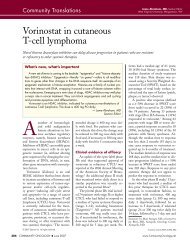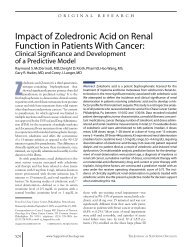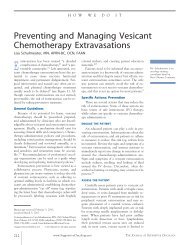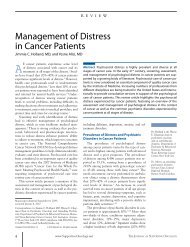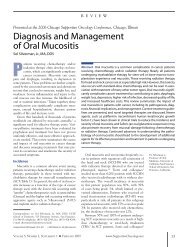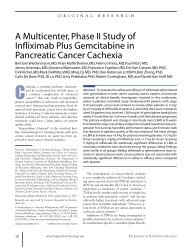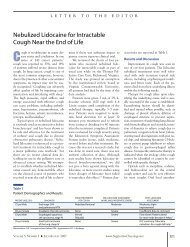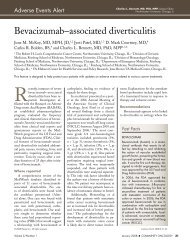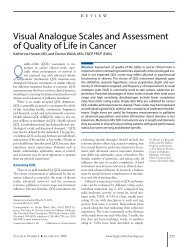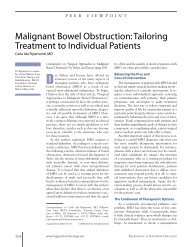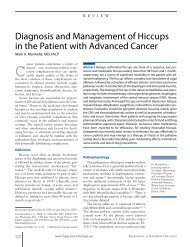Managing Bevacizumab-Related Toxicities in Patients with ...
Managing Bevacizumab-Related Toxicities in Patients with ...
Managing Bevacizumab-Related Toxicities in Patients with ...
You also want an ePaper? Increase the reach of your titles
YUMPU automatically turns print PDFs into web optimized ePapers that Google loves.
<strong>Manag<strong>in</strong>g</strong> <strong>Bevacizumab</strong>-<strong>Related</strong> <strong>Toxicities</strong> <strong>in</strong> <strong>Patients</strong> <strong>with</strong> Colorectal Cancer<br />
Table 1<br />
Major <strong>Toxicities</strong> of <strong>Bevacizumab</strong><br />
Frequency of ADVERSE EVENTS (%)<br />
HYPERTENSION PROTEINURIA BLEEDING Gastro<strong>in</strong>test<strong>in</strong>al WOUND<br />
STUDY BEVACIZUMAB DOSE (GRADE 3) (GRADE 3) THROMBOSIS (GRADE 3/4) PERFORATION HEALING<br />
AVF2107g 1,5 5 mg/kg every 2 weeks 11 1 19 a 3 2 nR<br />
E3200 6 10 mg/kg every 2 weeks 5 1 3 (VTE) 3 1 nR<br />
1 (ATE)<br />
BRiTE 7 5 mg/kg every 2 weeks 16 b NR 2 (ATE) 2 2 1<br />
First BEAT 8 5 mg/kg every 2 weeks (5-Fu 1 nR 1 (ATE) 1 1 nR<br />
regimens) or 7.5 mg/kg every<br />
2 (VTE)<br />
3 weeks (capecitab<strong>in</strong>e regimens)<br />
5-FU = 5-fluorouracil; NR = not reported; VTE = venous thromboembolic event; ATE = arterial thromboembolic event<br />
a<br />
Thromboembolism (listed as “any thrombotic event”)<br />
b<br />
Specified as hypertension requir<strong>in</strong>g medication<br />
tion. Results from these studies show that bevacizumab’s safety<br />
profile/tolerability is consistent <strong>with</strong> the safety observations<br />
from other studies.<br />
It is also importunate to note that these toxicities are a class<br />
effect for all anti-VEGF (vascular endothelial growth factor)<br />
therapy. As the cl<strong>in</strong>ical use of bevacizumab cont<strong>in</strong>ues to <strong>in</strong>crease<br />
<strong>in</strong> the treatment of CRC as well as other malignancies,<br />
it is prudent to understand the toxicities that can arise and<br />
know how to manage them. Therefore, the discussion that follows<br />
explores these toxicities and offers management recommendations<br />
based on experience and review of the literature.<br />
Selected <strong>Bevacizumab</strong>-Associated <strong>Toxicities</strong><br />
HYPERTENSION<br />
Incidence. Grade 3 hypertension is the most common toxicity<br />
associated <strong>with</strong> bevacizumab treatment. Grade 3 hypertension<br />
is def<strong>in</strong>ed as hypertension requir<strong>in</strong>g the addition or modification<br />
of antihypertensive agents. The overall rate of grade 3<br />
hypertension <strong>in</strong> phase III/IV studies is 1%–18%. 5 Hypertension<br />
can occur at any time dur<strong>in</strong>g the course of treatment, and preexist<strong>in</strong>g<br />
hypertension does not predispose patients to grade 2/3<br />
hypertension. No deaths from bevacizumab-associated hypertension<br />
have been reported. More than 1% of patients have<br />
discont<strong>in</strong>ued bevacizumab therapy because of hypertension.<br />
Grade 4 hypertension is rare (s<strong>in</strong>gle case <strong>in</strong> breast cancer phase<br />
II study). Blood pressure is typically controlled <strong>with</strong> a s<strong>in</strong>gle<br />
antihypertensive agent.<br />
Treatment Guidel<strong>in</strong>es. <strong>Patients</strong> receiv<strong>in</strong>g bevacizumab<br />
should always be observed for the development or worsen<strong>in</strong>g of<br />
hypertension through frequent blood pressure measurements.<br />
We encourage daily home monitor<strong>in</strong>g, if possible. Blood pressure<br />
measurements should occur after the patient has been <strong>in</strong> a<br />
rest<strong>in</strong>g position for ≥ 5 m<strong>in</strong>utes. Repeat measurement of blood<br />
pressure for verification should be undertaken if the <strong>in</strong>itial<br />
read<strong>in</strong>g is ≥ 140 mm Hg systolic and/or ≥ 90 mm Hg diastolic.<br />
In most cases, a s<strong>in</strong>gle-agent antihypertensive can control<br />
hypertension. Data from the BRiTE trial showed that for patients<br />
<strong>with</strong>out basel<strong>in</strong>e hypertension, 55% needed one medication,<br />
38% needed two medications, and 8% needed three or<br />
more medications. 7<br />
The selection of an antihypertensive regimen should be left<br />
to the treat<strong>in</strong>g physician. Standard antihypertensive therapy,<br />
typically angiotens<strong>in</strong>-convert<strong>in</strong>g enzyme (ACE) <strong>in</strong>hibitors,<br />
beta-blockers, calcium channel blockers, or diuretics, can be<br />
used to control grade 3 hypertension, and bevacizumab can be<br />
cont<strong>in</strong>ued <strong>with</strong>out dose modification. We generally use ACE<br />
<strong>in</strong>hibitors, based on some aspects of the biology of VEGF <strong>in</strong>hibitors<br />
and the possibility of decreas<strong>in</strong>g the amount of prote<strong>in</strong>uria;<br />
however, standard guidel<strong>in</strong>es for the selection of antihypertensive<br />
medications are appropriate. In addition to a mechanistic<br />
rationale, diuretics should also be used cautiously to treat<br />
bevacizumab-related hypertension due to potential worsen<strong>in</strong>g<br />
of dehydration secondary to chemotherapy-<strong>in</strong>duced diarrhea.<br />
We generally practice as well as recommend assess<strong>in</strong>g hypertension<br />
and other toxicities accord<strong>in</strong>g to the National Cancer<br />
Institute–Common Toxicity Criteria (NCI–CTC) grad<strong>in</strong>g,<br />
as such an evaluation can help physicians to make a decision<br />
comparatively easily (Table 2). Several guidel<strong>in</strong>es for manag<strong>in</strong>g<br />
hypertension associated <strong>with</strong> bevacizumab follow:<br />
• <strong>Bevacizumab</strong> should not be <strong>in</strong>itiated <strong>in</strong> patients <strong>with</strong> uncontrolled<br />
hypertension.<br />
• Blood pressure should be measured at least every 2 to 3<br />
weeks <strong>in</strong> patients treated <strong>with</strong> bevacizumab.<br />
• Blood pressure monitor<strong>in</strong>g may be required at more frequent<br />
<strong>in</strong>tervals <strong>in</strong> patients who develop hypertension dur<strong>in</strong>g<br />
treatment.<br />
• Blood pressure monitor<strong>in</strong>g should cont<strong>in</strong>ue at regular<br />
<strong>in</strong>tervals <strong>in</strong> patients <strong>with</strong> bevacizumab-<strong>in</strong>duced or bevacizumab-exacerbated<br />
hypertension, even if they have discont<strong>in</strong>ued<br />
bevacizumab.<br />
• <strong>Bevacizumab</strong> should be suspended or permanently discont<strong>in</strong>ued<br />
if hypertension cannot be managed <strong>with</strong> standard<br />
oral antihypertensive agents. 9<br />
• <strong>Bevacizumab</strong> should be permanently discont<strong>in</strong>ued if a<br />
hypertensive crisis occurs.<br />
PROTEINURIA<br />
Incidence. Although the risk is m<strong>in</strong>imal, severe prote<strong>in</strong>uria<br />
can occur <strong>in</strong> a few patients secondary to bevacizumab. In the<br />
246 www.SupportiveOncology.net Th e Jo u r n a l o f Su p p o rt i v e On c o l o g y



